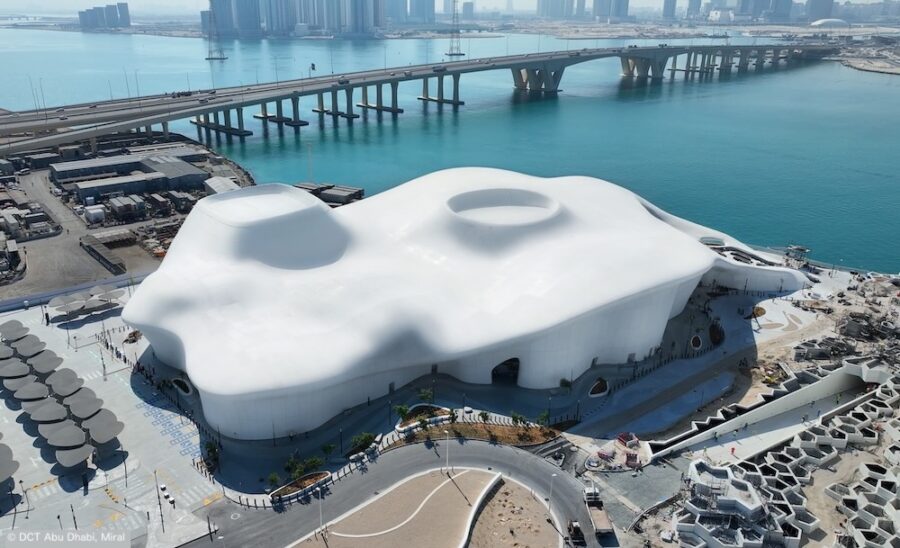
CULTURE


©︎ Francisco Nogueira

©︎ Francisco Nogueira
〈ファクトリー・リスボン(Factory Lisbon)〉は、1970年代に建てられたポルトガル軍の食品製造施設を複合用途の施設へと改修した、歴史的な建築物を保存するだけでなく現代に適合させ活用する「アダプティブリユース・プロジェクト」です。
細長いボリュームの既存の空間を阻害しないよう、外壁に沿って屋外廊下と階段を設置することで回遊性を高めています。また、大企業と小規模なスタートアップ企業のオフィススペース、イベントスペース、レストラン、一般開放されたテラスが一体となった、異なるスケールのプログラムと空間が混在した建築となっています。
ジュリアン・ブライナーズドルファー・アーキテクツ(Julian Breinersdorfer Architekten)、ジョゼ・バガーニャ・アーキテクツ(José Baganha Arquitectos)、アンジェラ・モーリス・アーキテクツ(Angela Maurice Arquitectos)が設計しました。
(以下、Julian Breinersdorfer Architektenから提供されたプレスキットのテキストの抄訳)

©︎ Francisco Nogueira

©︎ Francisco Nogueira
〈ファクトリー・リスボン〉は、1973年に建設されたポルトガル軍のパスタ・ビスケット工場のアダプティブリユース・プロジェクトであり、リスボン港に面した軍事施設保護地区に位置している。
この地区はリスボン市議会によりイノベーション地区「クリエイティブ・バブ・ベアト(Creative Hub Beato)」として生まれ変わろうとしている。

©︎ Francisco Nogueira

©︎ Francisco Nogueira
細長いボリュームを阻害することなく回遊性を高める屋外通路
パスタとビスケットの製造のために設計されたこの建物は、長さ200mに対し幅は11mしかない。この細長いボリュームのため、通常であれば避難用の廊下をいくつか導入する必要があるが、建物への過剰な介入を避けるため、廊下はすべて外側から取り付けることとした。
軽量金属フレームの通路と階段がファサードに沿って蛇行し、歴史的なサイロと建物中央のエレベーターシャフトの間を縫うように配置されている。
階段は天井から吊り下げることで構造への影響を最小限に抑え、エレベーター・シャフトは鏡で覆うことで、周囲の色彩や歴史的遺産を映し出し調和している。

©︎ Francisco Nogueira

©︎ Julian Breinersdorfer
多様なスケール、空間、イベントを受容する空間
屋外の回遊空間は、〈ファクトリー・リスボン〉のユニークな基本方針である「異なるスケールのプログラムと空間の混在」を反映した建築的な特徴の1つであり、大企業と小規模なスタートアップ企業のオフィススペースと、イベントスペース、レストラン、そして一般開放された2000m²のテラスが一体となっている。
デザインアプローチは、可能な限り既存の素材や色、質感を残しつつ、コンクリート、スチール、ガラス、木材などの現代的な要素とのコントラストをつけることにある。

©︎ Francisco Nogueira

©︎ Francisco Nogueira
〈ファクトリー・リスボン〉は、ベアトの地域コミュニティに良い影響を与えることを基本理念に掲げている。
地域や国内外を問わず、多様な人々が利用できる会場とすることに重点を置いており、テクノロジー、フード、ジェンダー、スケートボード、ファッション、建築、アート等のイベントが、営利・非営利を問わず開催されている。

©︎ Francisco Nogueira

©︎ Francisco Nogueira
建築コンセプトは、学際的かつ協力的な方法で開発された。
「与えられたコンテクストに沿い敬意を持ちながら大胆に建築を整える」というコンセプトは、ファクトリーの創設者サイモン・シェーファー(Simon Schaefer)と建築家ジュリアン・ブライナーズドルファー、ジョゼ・バガーニャ、アンジェラ・モーリスがこのプロジェクトに対し共有する精神である。

©︎ Francisco Nogueira

©︎ Francisco Nogueira
これらの設計原則に従い、すべての介入は金属の構造体による「ホワイト・スチール・ライン」で描かれており、歴史的建造物の外観はそのままに、必要な部分に対し追加・修正を行った。
また、歩道に加えて十字の筋交いを取り付け耐震性を高めている。レンガ造りのファサード部分には、光を取り入れつつ回遊性をもたせるため、白い窓枠の開口部を設け、背の高い空間を有効利用するため中2階を増設した。

©︎ Francisco Nogueira

©︎ Francisco Nogueira
建物の転換を可視化する、建物内を巡る設備
転換のために必要な設備は隠さずに建物に組み込まれており、まるで血管のように建物内を巡る設備は、古い食品製造施設を現代のオフィスやイベント施設へと適応させるという技術的な変換を可視化している。
植物や木材による造作要素は、1970年代のオリジナルの配色を維持しながら、非工業的な柔らかさをもたらしている。2台のビスケット製造機、黄色い穴あきレンガの壁、傷んだ大理石の階段などの歴史的なディテールは、慎重に修復され、統合されている。
すべての建材、仕上げ、配置、幾何学模様は、リスボンの街の幻想的な大西洋の光を反映し、反響させるために最新の注意を払い選択した。

©︎ Julian Breinersdorfer

©︎ Julian Breinersdorfer

©︎ Francisco Nogueira

©︎ Julian Breinersdorfer

©︎ Guillaume Bonn

©︎ Francisco Nogueira

©︎ Julian Breinersdorfer

©︎ Julian Breinersdorfer

Plans
以下、Julian Breinersdorfer Architektenのリリース(英文)です。
Main InformationProject Name: Factory Lisbon
Office Name (in title): Julian Breinersdorfer, José Baganha, Angela Maurice
Office Names (in credit): Julian Breinersdorfer Architekten, José Baganha Arquitectos, Angela Maurice ArquitectosOffice Website: julianbreinersdorfer.com
Social Media Accounts: instagram julian_breinersdorfer
Firm Location: BerlinCompletion Year: 2022
Gross Built Area (m²/ ft²): 12.400m²
Project Location: Lisboa, Portugal
Program / Use / Building Function: Mixed UseLead Architects: Julian Breinersdorfer, José Baganha, Angela MauricePhotographer
Photo Credits: Francisco Nogueira, Guillaume Bonn
Photographer’s Website: francisconogueira.comProject DescriptionFactory Lisbon is the adaptive reuse of a 1973 cookie and noodle factory of the Portuguese military. The heritage protected building sits on Lisbon‘s harbor front, in a historic army supply complex, currently being transformed into an innovation district, Hub Criativo de Beato.Shaped to house noodle machines, the building is 200m long and only 11m wide.This slender volume would normally require the introduction of several concrete cores for emergency circulation. In order to avoid such a disruptive intervention, all circulation has been attached externally. In the shape of lightweight steel walkways and single-flight stairs, it meanders along the façades, and weaves around the historic silos and an elevator shaft in the centre of the building. Here, the stairs are suspended from the ceiling, to minimise their structural impact. The new elevator shaft is clad with mirrors, so it blends with the historic colours and features.The ribbon-shaped circulation ties together Factory‘s unique blend of program and design principle: office spaces for large companies and start-ups are combined with event spaces, local restaurants and a 2.000m² public access roof terrace. The design approach is to retain old materials and surfaces wherever possible, and contrast with contemporary elements of concrete, steel, glass and wood.Factory Lisbon aims to make a multilayered and nuanced impact on Beato‘s local community. There is a strong focus on making the venue accessible to a diverse local and international public, beyond that of the typical conference business: current events cover tech, food, gender, skateboarding, fashion, architecture and art, on both a for- and non-profit basis.Architecture and concept have been developed in an interdisciplinary and collaborative effort. Aligning bold architecture respectfully along it’s given context is the shared Leitmotiv of Factory‘s founder Simon Schaefer, and the architects Julian Breinersdorfer, José Baganha and Angela Maurice.In-line with these design principles, all major interventions are drawn as white steel lines. They add or fix what is necessary, while leaving the historic building body legible and intact.In addition to the walkways, St. Andreas crosses have been attached to make the building earthquake resistant, brick façade elements have been opened as white-framed glazing, to bring light in or allow for circulation, and mezzanine floors have been extended to use high spaces more efficiently.The necessary technical installations are treated as veins, unashamedly taking their place in the building’s body. They are visible as technological transformations, adapting the functionality of an old food production facility to contemporary office and event uses.Plants and wooden buildout elements bring a nonindustrial softness, without leaving the 1970‘s palette. Historic details like two cookie machines, the yellow perforated brick walls, or damaged marble staircases have been lovingly restored and integrated.All building materials, finishes and geometries have been selected to vibrate with Lisbon‘s magic atlantic light.
Julian Breinersdorfer Architekten 公式サイト
https://julianbreinersdorfer.com/
Factory 公式サイト









